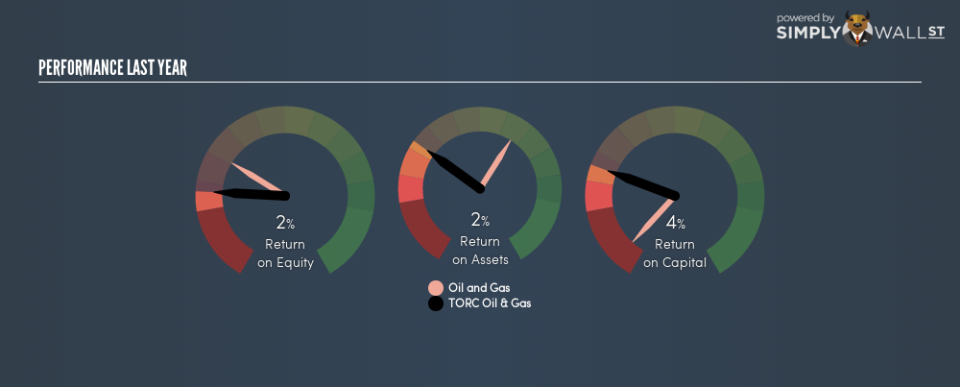Is TORC Oil & Gas Ltd. (TSE:TOG) Struggling With Its 3.7% Return On Capital Employed?

Today we are going to look at TORC Oil & Gas Ltd. (TSE:TOG) to see whether it might be an attractive investment prospect. In particular, we’ll consider its Return On Capital Employed (ROCE), as that can give us insight into how profitably the company is able to employ capital in its business.
First of all, we’ll work out how to calculate ROCE. Then we’ll compare its ROCE to similar companies. And finally, we’ll look at how its current liabilities are impacting its ROCE.
What is Return On Capital Employed (ROCE)?
ROCE measures the amount of pre-tax profits a company can generate from the capital employed in its business. Generally speaking a higher ROCE is better. In brief, it is a useful tool, but it is not without drawbacks. Author Edwin Whiting says to be careful when comparing the ROCE of different businesses, since ‘No two businesses are exactly alike.’
So, How Do We Calculate ROCE?
Analysts use this formula to calculate return on capital employed:
Return on Capital Employed = Earnings Before Interest and Tax (EBIT) ÷ (Total Assets – Current Liabilities)
Or for TORC Oil & Gas:
0.037 = CA$18m ÷ (CA$2.3b – CA$117m) (Based on the trailing twelve months to September 2018.)
Therefore, TORC Oil & Gas has an ROCE of 3.7%.
See our latest analysis for TORC Oil & Gas
Does TORC Oil & Gas Have A Good ROCE?
When making comparisons between similar businesses, investors may find ROCE useful. In this analysis, TORC Oil & Gas’s ROCE appears meaningfully below the 4.8% average reported by the Oil and Gas industry. This performance could be negative if sustained, as it suggests the business may underperform its industry. Regardless of how TORC Oil & Gas stacks up against its industry, its ROCE in absolute terms is quite low (especially compared to a bank account). It is likely that there are more attractive prospects out there.
TORC Oil & Gas reported an ROCE of 3.7% — better than 3 years ago, when the company didn’t make a profit. That implies the business has been improving.
It is important to remember that ROCE shows past performance, and is not necessarily predictive. Companies in cyclical industries can be difficult to understand using ROCE, as returns typically look high during boom times, and low during busts. ROCE is only a point-in-time measure. We note TORC Oil & Gas could be considered a cyclical business. Future performance is what matters, and you can see analyst predictions in our free report on analyst forecasts for the company.
What Are Current Liabilities, And How Do They Affect TORC Oil & Gas’s ROCE?
Current liabilities are short term bills and invoices that need to be paid in 12 months or less. Due to the way ROCE is calculated, a high level of current liabilities makes a company look as though it has less capital employed, and thus can (sometimes unfairly) boost the ROCE. To counter this, investors can check if a company has high current liabilities relative to total assets.
TORC Oil & Gas has total assets of CA$2.3b and current liabilities of CA$117m. As a result, its current liabilities are equal to approximately 5.0% of its total assets. TORC Oil & Gas has a low level of current liabilities, which have a negligible impact on its already low ROCE.
What We Can Learn From TORC Oil & Gas’s ROCE
Nonetheless, there may be better places to invest your capital. Of course, you might find a fantastic investment by looking at a few good candidates. So take a peek at this free list of companies with modest (or no) debt, trading on a P/E below 20.
If you are like me, then you will not want to miss this free list of growing companies that insiders are buying.
To help readers see past the short term volatility of the financial market, we aim to bring you a long-term focused research analysis purely driven by fundamental data. Note that our analysis does not factor in the latest price-sensitive company announcements.
The author is an independent contributor and at the time of publication had no position in the stocks mentioned. For errors that warrant correction please contact the editor at editorial-team@simplywallst.com.

 Yahoo Finance
Yahoo Finance 
